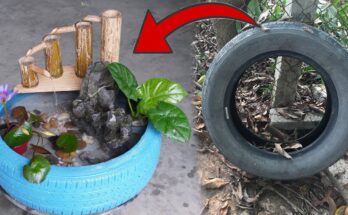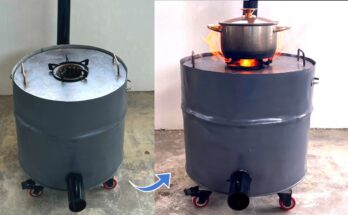Briquettes are an excellent way to recycle waste materials like sawdust, paper, and agricultural residues into a sustainable fuel source. A briquette machine compacts these materials into dense blocks that are easy to burn, making them ideal for cooking, heating, or other uses. While commercial briquette machines can be expensive, you can create your own homemade briquette-making machine using a drill machine. This DIY project is cost-effective, environmentally friendly, and simple to assemble.
Materials You’ll Need:
- Drill Machine: A standard electric drill will serve as the power source.
- Steel Pipe: A pipe with a diameter suitable for your desired briquette size will act as the compression chamber.
- Plunger: A metal or wooden plunger that fits snugly into the pipe for compressing materials.
- Wooden or Metal Frame: A sturdy frame to mount the components.
- Threaded Rod or Screw: To create the mechanical press mechanism.
- Washers and Nuts: For securing the components.
- Recyclable Materials: Sawdust, paper, or other biomass for making the briquettes.
- Glue or Starch: As a binding agent for the briquettes.
Step-by-Step Guide
Step 1: Prepare the Base and Frame
Start by constructing a sturdy base and frame for your briquette machine. Use a thick wooden plank or a metal sheet as the base, and build a frame using metal rods or wood. The frame should be strong enough to support the compression chamber and the drill machine.
Step 2: Create the Compression Chamber
Cut a steel pipe to the desired length for your briquettes. This pipe will serve as the compression chamber. Drill small holes along the sides of the pipe to allow excess water to drain during the briquetting process.
Step 3: Attach the Compression Chamber to the Frame
Secure the steel pipe vertically onto the frame using clamps or brackets. Ensure the pipe is tightly fastened and stable, as it will endure significant pressure during operation.
Step 4: Build the Plunger Mechanism
Create a plunger using a wooden or metal rod that fits snugly into the steel pipe. Attach the plunger to a threaded rod or screw, which will act as the mechanical press. Secure the threaded rod to the frame and connect it to the drill machine using a coupling or adapter.
Step 5: Connect the Drill Machine
Mount the drill machine horizontally onto the frame. Ensure the drill chuck is aligned with the threaded rod. When activated, the drill will rotate the rod, driving the plunger to compress the materials in the chamber.
Step 6: Prepare the Briquette Mixture
Mix your recyclable materials, such as sawdust, paper, or agricultural residues, with water and a binding agent like glue or starch. The mixture should have a dough-like consistency.
Step 7: Compress the Mixture
Place the mixture into the steel pipe and activate the drill machine. The plunger will compress the material, forming a dense briquette. Hold the pressure for a few seconds, then remove the formed briquette.
Step 8: Dry the Briquettes
Place the briquettes in a sunny, well-ventilated area to dry completely. Drying is essential to ensure the briquettes burn efficiently.
Benefits of a Homemade Briquette Machine
- Cost-Effective: Build your own briquette machine at a fraction of the cost of a commercial one.
- Eco-Friendly: Recycle waste materials into a usable fuel source.
- Versatile: Customize the machine to produce briquettes of different sizes and shapes.
Safety Tips
- Wear protective gloves and goggles during operation.
- Ensure the machine is securely fastened to prevent movement.
- Do not overload the compression chamber.
Creating a homemade briquette machine using a drill machine is a rewarding DIY project. It allows you to recycle waste materials into an eco-friendly and cost-effective fuel source, helping you reduce waste and promote sustainability. With this machine, you can produce briquettes for personal use or even as a small business venture!


